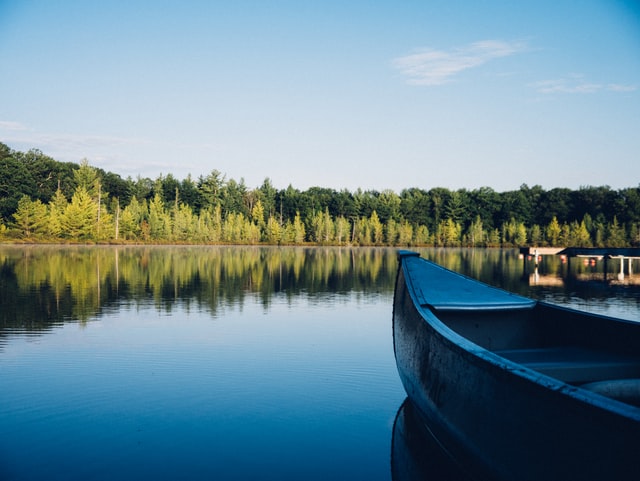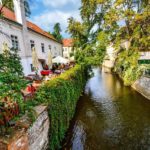Searching for the Origin of the Mississippi

“Let’s go to find where the Mississippi starts. They call it the headwaters,” I suggested to my children a few years after we had come to live in the Quad Cities where the Mississippi flows East to West, dividing Iowa from Illinois, as it courses downstream to enter the Gulf of Mexico 2850 miles from its origin in Minnesota. They were enthusiastic about the trip.
I arranged to rent a cabin in the woods for a week on a lake fairly near to Lake Itasca, and on our arrival in glorious sunshine, after a 7 hour drive, we went into town to buy fishing rods and get a license. A small rowing boat was provided with the cabin, so I thought we would try something new. It was early June the begin-ning of their summer vacation. I feared the lake water may still be too cold for swimming.,
We took the boat out almost as soon as we had unloaded everything we needed for the week, including groceries, so we wouldn’t have to spend much time shop-ping. We didn’t catch any fish that evening, but I promised to ask our hosts the next day what they used for bait in the hope of better luck in future. They had told us if we caught a fish and wanted them to clean and filet it, we only had to ask.
Let’s go to find where the Mississippi starts.
As the children went to bed just after 8.30p.m., it started raining, at first light rain, then heavier and heavier. The wind howled as I went to bed but we all slept soundly. We opened the door the next morning and the rain was already up to the level of the first step. we were completely surrounded by water. It kept rain-ing.
Fortunately, I’d packed plenty of books and a few games – we had a pack of play-ing cards too, and there was a jigsaw and a board game in the wooden cabin, so after breakfast we played. By the third day, when the water was up to the second step almost level with the lower edge of the door, we felt like we were in Noah’s Ark. One of the Czupka boys in thigh length waders they used for fishing in the lake had come around the day before and asked if we needed anything and if we had enough food. They offered to bring some if we didn’t, as the rain was fore-cast to continue for at least another day.
Fortunately we had raincoats and Wellingtons because I thought it might rain and we liked to explore anyway. I decided if the boys could tow us out of the camp to higher ground if they thought the roads would be clear, we would go and find a “logging camp” opened now as a tourist attraction where they served lunches as they would to the men who lived in the primitive camp in the early 1900s. I kept thinking of Freckles by Gene Stratton Porter which had been one of my favorite books as an early teen. We arrived and I was leery of getting stuck in mud, but there was a black-topped parking lot so we were fine. The lunch “tent” was open both ends in among the trees, with long picnic tables and benches.
The lunch “tent” was open both ends in among the trees, with long picnic tables and benches.
At the buffet on the side were tin plates and tin spoons and forks, offerings of mashed potato, carrots, turnips and greens – which I assumed was cooked spin-ach, and burgers, less than McDonald’s 1/4 pounders. Ketchup was the only con-diment supplied. Quantity was plentiful but quality not great. Tin mugs and jugs of water were supplied on the tables. I hoped the experience would stimulate dis-cussion of how people lived, and some of the hardships the loggers suffered.
Having ventured out in spite of the continuing rain, we returned for another sup-per in the cabin and more games. I told David and Caroline that we should go to find the source of the Mississippi the next day even if it was still raining.
We squelched our way through the trees from the carpark and waded through the little stream which was the outflow of Lake Itasca, using some of the boulders in it as stepping stones where they were flat and well placed, but we didn’t go hiking since the rain was relentless.
When we reached the camp where we were staying, one of the boys opened the gate and directed me to leave the car on higher ground and told me the forecast was continuous rain for the next several days. So over supper, we decided we would not be able to go fishing or boating and perhaps we should abandon the backwoods and find a motel in Minneapolis where we could visit Fort Snelling at the confluence of the Minnesota and Mississippi Rivers and perhaps the Science Museum too.
The next morning, one of the boys came to help us carry all our belongings to the car and we bid them goodbye. After finding a motel in Minneapolis, we headed to the Science Museum for a fun afternoon staying dry, enjoying the hands on ac-tivities and learning more about the Native Americans who lived in this region be-fore the colonists came.
Searching for the Origin of the Mississippi.
The last day before driving back to the Quad Cities was enjoyed at Fort Snelling, The Fort was one of several in Minnesota built in the 1820s, and had various uses until it was decommissioned after the 2nd World War in 1946. It is still used for some National Guard troops and special military events. At one time, when the USA entered World War ll in December 1941, it was used as an entry point for new recruits. They could process up to 800 per day , giving them medicals, assessing skills and assigning them to units then dispatching them for basic training all over the country.
It was used to train Military Police and notably a 99th Infantry battalion which comprised only Norwegian-speaking soldiers who were trained to fight on skis and snowshoes. They proved most useful to infiltrate the Nazis when they were occupying Norway. At one time it was the home of the Military Intelligence Language School and many speaking all the Pacific Basin languages were stationed there.
The week wasn’t what I was expecting, but we had a fun time and came back with a clearer understanding of life for the early pioneers and loggers as well as picture of where this mighty river started its journey south.
Photo for Searching for the Origin of the Mississippi by Unsplash.








